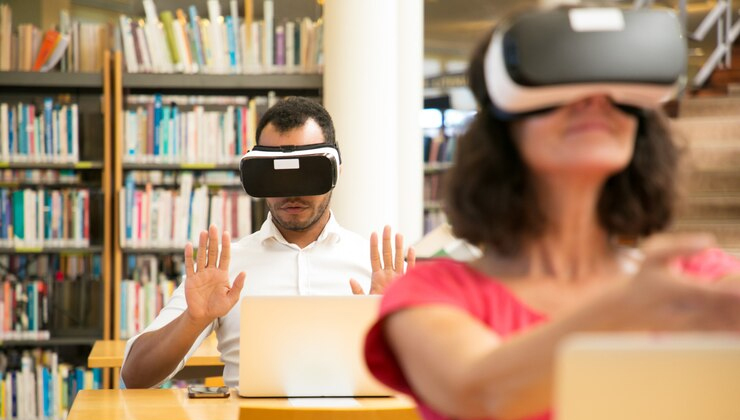
Virtual Reality (VR) is reshaping the education and training landscape in ways we couldn't have imagined a decade ago. As immersive technology, VR introduces an entirely new dimension to learning and skill development, breaking away from traditional methods and creating unique experiences that are more engaging and impactful. The power of VR lies in its ability to create simulated, interactive environments where learners can explore, experiment, and apply knowledge in real-time—something conventional methods can't achieve.
Imagine stepping into the shoes of an astronaut, surgeon, or architect without ever leaving your classroom. With VR, this isn't a far-off dream but a reality that allows learners to engage deeply with content. In education, students no longer need to rely on textbooks or videos for abstract concepts; they can now experience lessons in a multi-dimensional space. Whether navigating the solar system in a virtual astronomy lesson or walking through the intricate layers of the human body, VR adds depth to learning, transforming abstract ideas into real-world applications.
This level of immersion taps into how humans learn best—through experience. Instead of simply absorbing information, students actively participate in the learning process. This not only strengthens understanding but makes learning more dynamic, paving the way for creativity and critical thinking to flourish in an otherwise traditional educational setting.

When it comes to training, the stakes are higher, especially in industries like healthcare, aviation, and construction, where mistakes can lead to serious consequences. VR is a game-changer in these fields. It offers professionals the ability to practice in a risk-free virtual environment. Think of medical students performing complex surgeries or pilots navigating challenging flight conditions—all without the real-world dangers. Mistakes, in this context, become opportunities for learning, not liabilities.
In this controlled environment, individuals can practice as many times as needed, building their confidence and refining their skills without fear of failure. The beauty of VR in training lies in its adaptability—trainers can create numerous scenarios, replicating real-world conditions or inventing entirely new ones, all while maintaining complete control over the environment.

Learning is most effective when it's engaging, and VR effortlessly takes engagement to an entirely new level. Traditional learning methods often struggle to hold attention, but VR has the ability to capture and sustain it. By immersing individuals in an interactive experience, VR stimulates the senses, pulling learners deeper into the material.
This interactive engagement activates multiple areas of the brain, enhancing information retention. When learners are actively involved in exploring and manipulating their virtual environment, the material they are engaging with feels real and immediate. The result is that knowledge sticks better and longer than through passive learning approaches.
One of VR's most transformative effects on education and training is its ability to eliminate geographical barriers. With virtual reality, learners no longer need to be physically present to access high-quality education or training. Students from different corners of the globe can participate in the same virtual classroom or training session. For those in remote or underserved areas, VR becomes a gateway to opportunities that would otherwise be out of reach.
The virtual classroom is not a faceless video call—it's an immersive space where students can interact with instructors and peers as though they were in the same room. This shared space allows collaboration and communication to happen naturally, mirroring real-life dynamics despite physical separation.

While adopting VR technology requires an initial investment, the long-term savings and benefits often outweigh the upfront costs. Industries that require extensive hands-on training—like aviation, manufacturing, or surgery—can simulate real-world scenarios without the need for expensive equipment or travel. This also means reduced downtime for employees who might otherwise need to train on specialized machines or in off-site locations.
Additionally, virtual environments can be modified and reused, providing a sustainable solution to training needs. This adaptability ensures that companies can continue evolving their training programs in line with technological advancements and industry demands without incurring huge costs.

One of the most remarkable aspects of VR is its inclusivity. The technology can be customized to suit the needs of diverse learners, including those with disabilities. A student with limited mobility, for example, can still experience a virtual field trip to a historical site, or a learner with visual impairments can benefit from auditory and tactile enhancements built into the virtual environment.
VR also allows for adaptive learning, where the difficulty level can be adjusted based on individual progress. This makes learning a truly personalized experience, catering to various abilities and learning speeds, while ensuring that every participant gets the most out of the experience.
Through these lenses, the impact of Virtual Reality on education and training isn't just a technological advancement—it's a fundamental shift in how knowledge is absorbed, practiced, and applied. The boundaries of traditional learning are being dismantled, and VR is at the forefront of this revolution, opening doors to immersive, hands-on learning like never before.
Consumers Guide membership grants you early bird access to the latest tech gadgets on the market, as well as huge discounts that aren't available to anyone else. Sign up below to receive all the latest deals on tech gadgets that are ideal as gifts for any occasion, before they're available to the mass market. Membership of Consumers Guide is completely free - no strings attached! Once you sign up, you will occasionally receive newsletters sent to your inbox with all the latest and greatest gadget discounts and deals - you also can unsubscribe at any time. To join for free, simply enter your e-mail below and click "Subscribe":